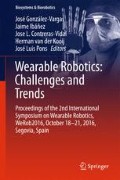Abstract
Worldwide, a significant interest in wearable robots or exoskeletons does exist, also from an industrial background. This paper provides an overview of assistive exoskeletons that have specifically been developed for industrial purposes. It discusses their potential in increasing performance and flexibility on one hand and in reducing the mechanical loads on workers involved in manual work on the other. From this it is concluded that exoskeletons have the potential to increase performance under specific conditions and to reduce physical loads significantly. However, several technical issues hinder mainstay practical use of exoskeletons in industry until now. One main issue concerns the human-machine interaction which stands in the way of acceptance. This issue and its linkage to ethics and standardization will be discussed during the conference.
Access this chapter
Tax calculation will be finalised at checkout
Purchases are for personal use only
References
Eurofound, 2012. Fifth European Working Conditions Survey, Publications Office of the European Union, 978-92-897-1062-6. Publications Office of the European Union, Luxembourg (2012)
Viteckova, S., Kutilek, P., Jirina, M.: Wearable lower limb robotics: a review. Biocybern. Biomed. Eng. 33(2), 96–105 (2013)
Kobayashi, H., Aida, T., Hashimoto, T.: Muscle suit development and factory application. Int. J. Autom. Technol. 3(6), 709–715 (2009)
Muramatsu, Y., Kobayashi, H., Sato, Y., Jiaou, H., Hashimoto, T., Kobayashi, H.: Quantitative performance analysis of exoskeleton augmenting devices-muscle suit-for manual worker. Int. J. Autom. Technol. 5(4), 559–567 (2011)
Kim, W.S., Lee, H.D., Lim, D.H., Han, C.S.: Development of a lower extremity exoskeleton system for walking assistance while load carrying. In: Proceedings of the Sixteenth International Conference on Climbing and Walking Robots, Sydney, Australia, pp. 35–42, 14–17 July 2013
Kawabata, T., Satoh, H., Sankai, Y.: Working posture control of robot suit HAL for reducing structural stress. In: 2009 IEEE International Conference on Robotics and Biomimetics (ROBIO), pp. 2013–2018. IEEE (2009)
Yu, W., Rosen, J.: A novel linear PID controller for an upper limb exoskeleton. In: 2010 49th IEEE Conference on Decision and Control (CDC), pp. 3548–3553. IEEE (2010)
Kadota, K., Akai, M., Kawashima, K., Kagawa, T.: Development of power-assist robot arm using pneumatic rubbermuscles with a balloon sensor. In: The 18th IEEE International Symposium on Robot and Human Interactive Communication, 2009. RO-MAN 2009, pp. 546–551. IEEE (2009)
Abdoli-Eramaki, M., Stevenson, J.M.: The effect of on-body lift assistive device on the lumbar 3D dynamic moments and EMG during asymmetric freestyle lifting. Clin. Biomech. 23, 372–380 (2008)
Barret, A.L., Fathallah F.A.: Evaluation of four weight transfer devices for reducing loads on the lower back during agricultural stoop labor. Paper number 01–8056 of the ASAE Meeting, Sacramento, USA (2001)
Godwin, A.A., Stevenson, J.M., Agnew, M.J., Twiddy, A.L., Abdoli-E, M., Lotz, C.A.: Testing the efficacy of an ergonomic lifting aid at diminishing muscular fatigue in women over a prolonged period of lifting. Int. J. Ind. Ergon. 3, 121–126 (2009)
Lotz, C.A., Agnew, M.J., Godwin, A.A., Stevenson, J.M.: The effect of an on-body personal lift assist device (PLAD) on fatigue during a repetitive lifting task. J. Electromyogr. Kinesiol. 19(2), 331–340 (2009)
Sadler, E.M., Graham, R.B., Stevenson, J.M.: The personal lift-assist device and lifting technique: a principal component analysis. Ergonomics 54(4), 392–402 (2011)
Acknowledgments
This research was supported by the European shared cost project Robo-Mate, funded under the Seventh Framework Program [grant number FP7-2013-NMP-ICT-FOF].
Author information
Authors and Affiliations
Corresponding author
Editor information
Editors and Affiliations
Rights and permissions
Copyright information
© 2017 Springer International Publishing AG
About this paper
Cite this paper
de Looze, M.P., Krause, F., O’Sullivan, L.W. (2017). The Potential and Acceptance of Exoskeletons in Industry. In: González-Vargas, J., Ibáñez, J., Contreras-Vidal, J., van der Kooij, H., Pons, J. (eds) Wearable Robotics: Challenges and Trends. Biosystems & Biorobotics, vol 16. Springer, Cham. https://doi.org/10.1007/978-3-319-46532-6_32
Download citation
DOI: https://doi.org/10.1007/978-3-319-46532-6_32
Published:
Publisher Name: Springer, Cham
Print ISBN: 978-3-319-46531-9
Online ISBN: 978-3-319-46532-6
eBook Packages: EngineeringEngineering (R0)

